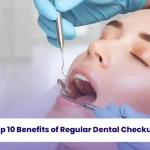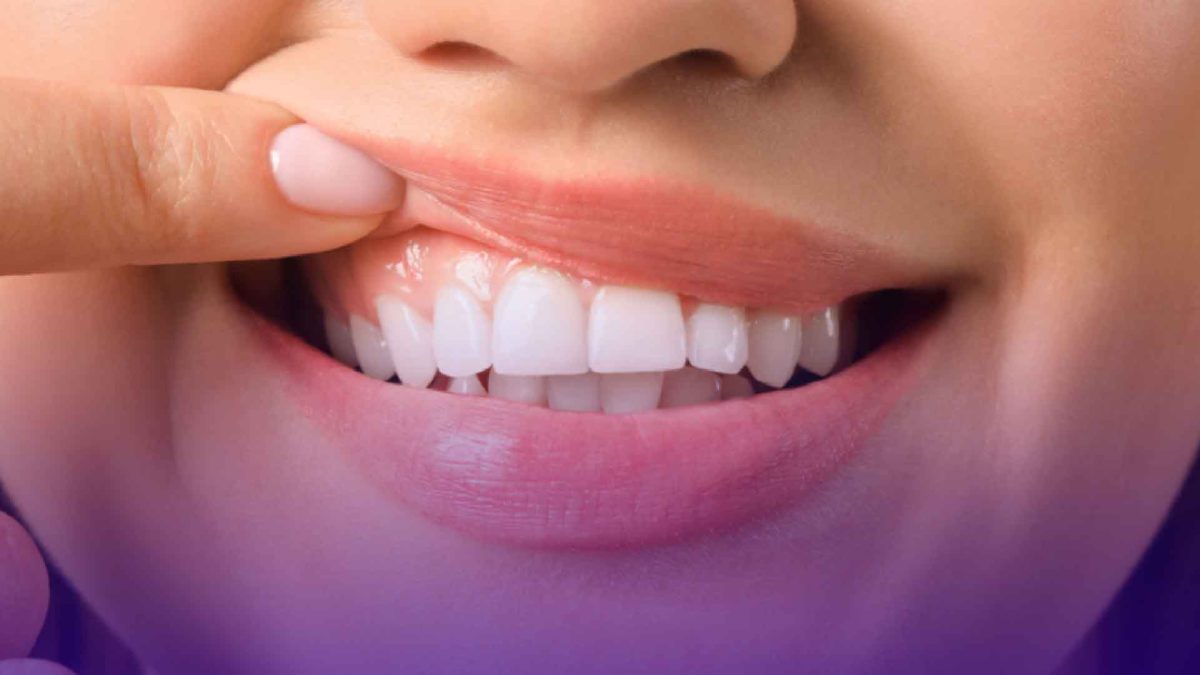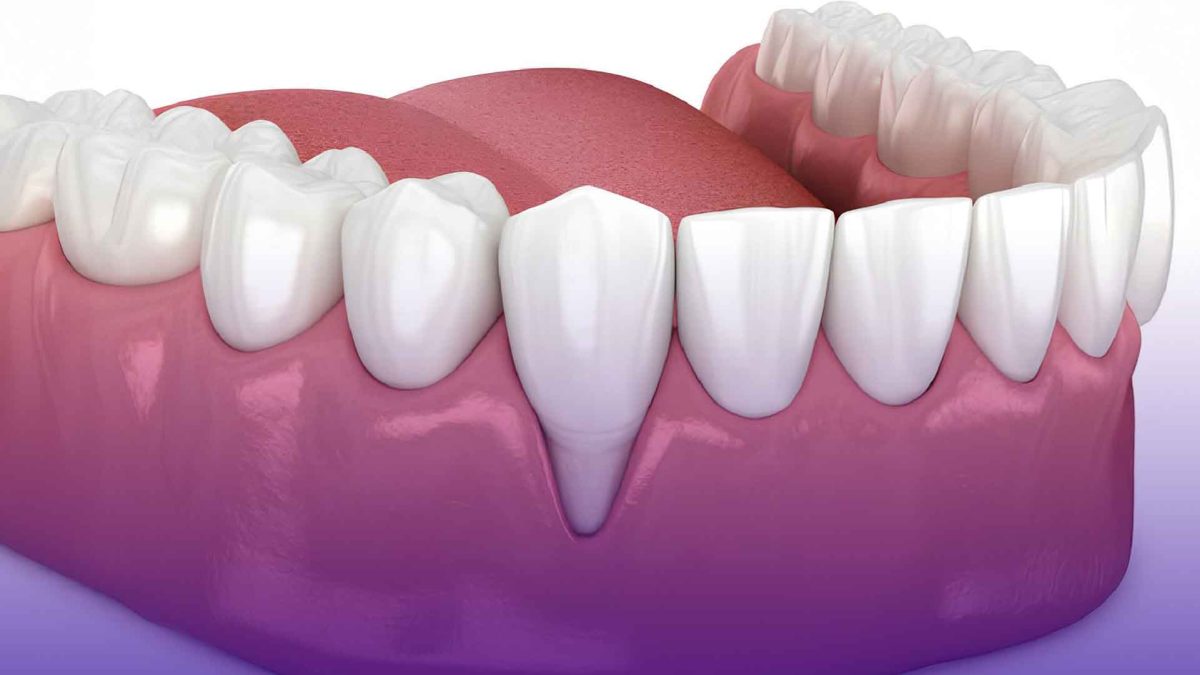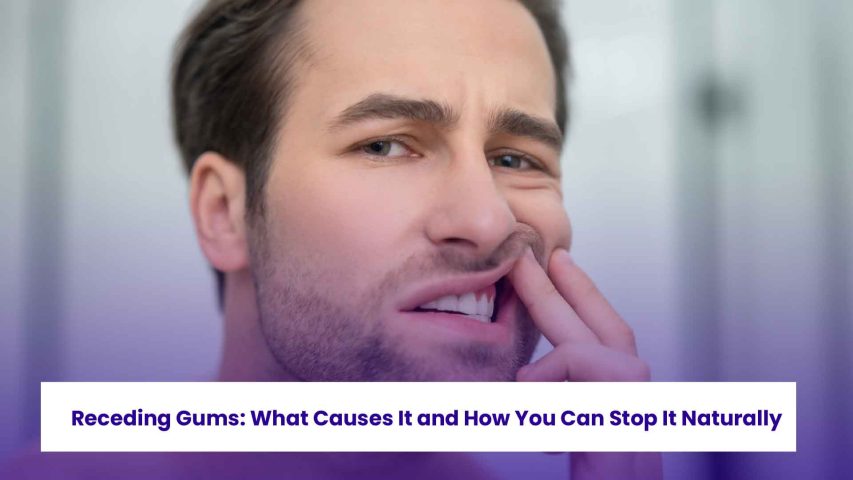
Why Is Invisalign Better Than Braces?
21 June 2025
Top 10 Benefits of Regular Dental Checkups
10 July 2025Receding Gums: What Causes It and How You Can Stop It Naturally
Gum recession serves as a very popular dental issue, yet it is seldom identified until very evident symptoms make their appearance. Most individuals do not even realize they have receding gums until the day when they are being more sensitive with their teeth or when they compare their present smile with the past. Understanding the gum recession causes is crucial not just for preventing further damage but also for exploring natural, non-invasive solutions. With surgery and clinical procedures available in abundance, today, more people are resorting to gentle, holistic treatment methods for their gums.
There is no one sure shot cure for gum recession. You could be the lifestyle you choose, your oral hygiene habits you follow, or simply your genes. Fortunately, though, several options exist for handling this problem, so if you are on track to protect your gums and maybe even reverse some damage, this means you have come to the right place. We’ll let you navigate through the main causes of gum recession and delve into the best natural remedies to treat and improve gum condition.
Now, let’s get into all the details about what is causing this gum condition and how to stop the receding, using natural remedies effectively.

Top Gum Recession Causes You Should Know
The first thing to do, majorly once one acknowledges the possibilities of recession, is to see what incites it in the first place. One of the main gum recession causes is poor oral hygiene. Poor brushing and flossing create plaque, whose existence irritates the gums and makes them slowly pull away from teeth. Over time, this creates pockets where bacteria internal and causes further tissue damage.
Yet another major cause of gum recession is abrasive brushing. Most people think that the harder you brush, the cleaner your teeth become; however, vigorous brushing causes the enamel to wear and pushes the gums back. Combine that with a hard bristled toothbrush, and we’ve got a recipe for gum recession. So while we clean, let’s not abrade.
Finally, the other reasons are hormonal changes in the body, mostly affecting women, or the usage of tobacco. The fluctuations in hormonal levels leave their gums extremely sensitive and easily prone to damage. Smoking or the usage of tobacco products impairs blood circulation to the gums, thereby preventing the tissue from healing or regenerating. All of these are critical gum recession causes that can be mitigated with awareness and preventive care.
How to Stop Receding Gums Without Surgery
When the term gum recession is uttered, many immediately picture gums all stitched up after a graft. The situations are not always so extreme. One thing someone would like to try is how to stop receding gums by way of better daily habits. That is to say, switch to a soft bristle toothbrush, use circular motions instead of strokes back and forth, and most importantly, keep on flossing and rinsing.

Changing your diet can also help against gum recession. Eating foods high in nutrients for great gums, leafy greens, carrots, and dairy makes tissue strong and reduces inflammation. Then, with vitamin C turning collagen around, one fixes his or her gums. In addition, drinking lots of water is essential: dry mouth speeds up gum damage.
Consider a gum massage technique for stopping receding gums naturally. Using either the tips of fingers or a gentle rubber tip, it’s a matter of gentle rubbing of the gums to stimulate the flow of blood and facilitate healing. With regular application, such a treatment will strengthen gum tissue over time.
Natural Remedies for Receding Gums That Actually Work
If natural remedies are what you’re after to halt receding gums, you will find several efficacious solutions to choose from. Oil pulling is one such method whereby a little bit of coconut or sesame oil is swished around in the mouth for a period of 10 to 20 minutes. This ancient Ayurvedic practice is thought to somehow contain plaque buildup and improve gum health by eliminating all the harmful bacteria.
Another natural treatment is aloe vera gel. Because of its anti-inflammatory and antibacterial capabilities, aloe works well to lessen swelling and encourage tissue regeneration. You may use pure aloe vera gel applied directly to your gums or buy toothpaste and mouthwash containing it as one of the prominent ingredients.
Another famous remedy is green tea. It is full of antioxidants, catechins, in particular, which fight inflammation and resist further damage. From one to two cups a day would aid your gum health, making it one of the easiest remedies anyone could integrate into their routine for receding gums.
Gum Recession Treatment Options at Home
You don’t have to start gum recession treatment with a dental chair. One of the simplest options available is salt water rinses. Salt has antibacterial properties that naturally reduce inflammation and promote healing. Twice daily warm salt water rinses can make a big difference in gum sensitivity and overall gum health.
Another home remedy is applying the turmeric paste to the gums. Turmeric contains curcumin, a substance that is rich in anti-inflammatory compounds. Just mix a little turmeric with water and make into a paste and apply it to the affected areas and leave for a minute or so before rinsing off. Doing this frequently can contribute to overall gum health.
Hydrogen peroxide is another popular remedy. A weak solution (3%) can be mixed with water and used as a rinse in the mouth to destroy bacteria and remove buildup from the gum line. Just don’t overdo it—twice or thrice weekly is sufficient. These easy gum recession treatment remedies are inexpensive and simple to integrate into your routine care.
Home Remedies for Gum Recession That Are Worth Trying
There’s growing interest in home remedies for gum recession, especially among those seeking alternatives to costly procedures. One such remedy that can be employed is tea tree oil. Loaded with antimicrobial activity, it is feasible to dilute it with a carrier oil and apply it directly on the gums to reduce bacterial loads and inflammation.
Clove oil is another traditional favorite. It’s an analgesic, so it can reduce the pain that comes with receding gums at times. Just use a small amount on the affected area with a cotton swab. Don’t use it too liberally though—clove oil is potent and should only be used with caution.
Lastly, proper hydration and the elimination of sweet treats can’t be overstated. Sugar and dry mouth nourish the bacteria that lead to gum issues. Proper hydration and crunchy fruits like apples are able to naturally flush out your teeth and strengthen gums. These home remedies for gum recession are practical, safe, and proven to offer relief when used consistently.
Is There a Receding Gums Natural Cure?
People often wonder if there’s a receding gums natural cure, and while “cure” might be a strong word, there are certainly ways to halt and possibly reverse the early stages of gum recession.Natural treatment is very effective when started early and consistently applied. Many people actually experience improvement without ever needing surgery.
An integrated approach comprises not just local care, but also reducing stress. Chronic stress is unhealthy for your immune system, and a compromised immune system complicates your gums healing. Yoga, meditation, and even leisurely walking may reduce stress and promote general gum well being.
In the meantime, the cessation of smoking and alcohol consumption can hasten recovery. When combined with good nutrition and proper oral hygiene, this approach can act as a powerful receding gums natural cure—helping you maintain your smile without invasive procedures.

How to Stop Gum Recession Through Lifestyle Changes
If you’re determined to know how to prevent gum recession, lifestyle changes should be your initial line of action. The most efficient change you can institute is in your brushing technique. Brushing softly using fluoride toothpaste twice daily and consistent flossing go a long way towards avoiding plaque.
Sleep habits are also crucial. Grinding your teeth at night (bruxism) causes your gums too much stress, and they will recede because of it. Your custom night guard will stop this from happening and spare your gums and teeth in the long term. It’s a tiny investment for a huge return.
Finally, regular visits to the dentist are a necessity. With or without home treatment, a dentist will pick up on early gum problems and track your progress. The mutual collaboration here will educate you exactly how to avoid gum recession and enjoy healthy gums for a lifetime.
The Latest New Treatment for Receding Gums
With advances in dental therapy, there’s a new alternative for receding gums that’s gaining popularity now—pinhole surgical technique (PST). PST is less painful than the traditional gum grafting and doesn’t require sutures. PST involves making a tiny pinhole in the gum tissue and repositioning it over roots.
Laser treatment is another state of the art procedure. Not only does it kill bacteria, but it also stimulates gum tissue growth. It typically is pain free and has no downtime. Patients prefer it because of its non surgical technique and instantaneous results.
Biocompatible materials and growth factors are also being explored in new treatments. These substances are applied directly to the gum line to encourage natural healing. As more studies confirm their effectiveness, these modern approaches may soon become the gold standard in treating gum recession. If you’re looking for a new treatment for receding gums, it’s worth discussing these innovations with your dentist.
Understanding the reasons for gum recession is the starting point to preventing the issue and taking control of your dental wellbeing. While surgery can be an option, the majority of individuals can even obtain real results using natural treatments and treatments at home. Oil pulling, green tea, turmeric, and essential oils are only a few among many techniques that can act against gum recession.
Consistency and vigilance are the name of the game. The earlier you identify the signs and begin to make changes, the better the chances that you will regain your gum health with minimal interventions. Don’t wait until you experience extreme sensitivity or tooth movement—take action now with the treatments and regimens we’ve discussed.
By focusing on natural care, routine maintenance, and becoming knowledgeable about gum recession causes, you can protect your smile and even possibly reverse early damage. Prevention, after all, is the best medicine.













